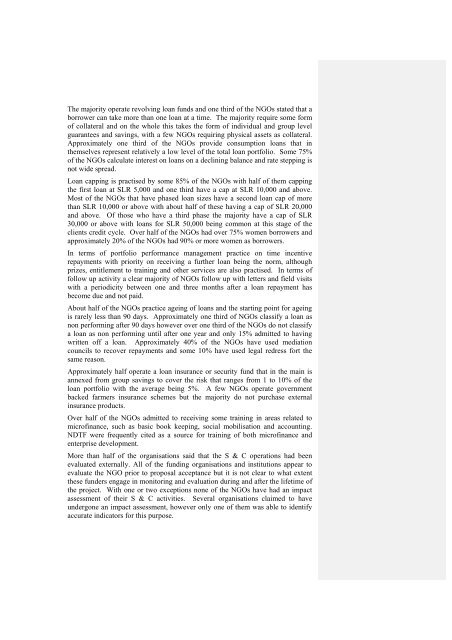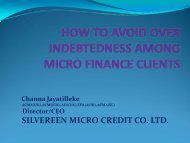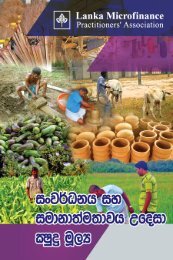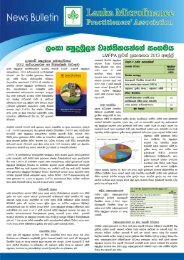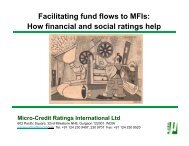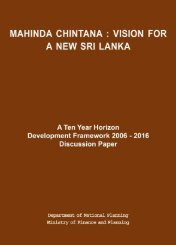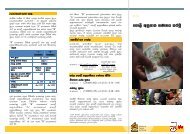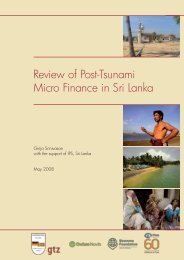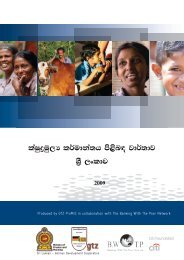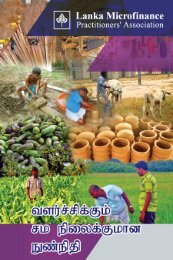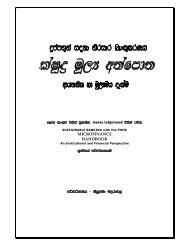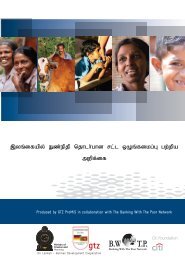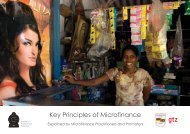National Microfinance Study of Sri Lanka: Survey of Practices and ...
National Microfinance Study of Sri Lanka: Survey of Practices and ...
National Microfinance Study of Sri Lanka: Survey of Practices and ...
You also want an ePaper? Increase the reach of your titles
YUMPU automatically turns print PDFs into web optimized ePapers that Google loves.
The majority operate revolving loan funds <strong>and</strong> one third <strong>of</strong> the NGOs stated that a<br />
borrower can take more than one loan at a time. The majority require some form<br />
<strong>of</strong> collateral <strong>and</strong> on the whole this takes the form <strong>of</strong> individual <strong>and</strong> group level<br />
guarantees <strong>and</strong> savings, with a few NGOs requiring physical assets as collateral.<br />
Approximately one third <strong>of</strong> the NGOs provide consumption loans that in<br />
themselves represent relatively a low level <strong>of</strong> the total loan portfolio. Some 75%<br />
<strong>of</strong> the NGOs calculate interest on loans on a declining balance <strong>and</strong> rate stepping is<br />
not wide spread.<br />
Loan capping is practised by some 85% <strong>of</strong> the NGOs with half <strong>of</strong> them capping<br />
the first loan at SLR 5,000 <strong>and</strong> one third have a cap at SLR 10,000 <strong>and</strong> above.<br />
Most <strong>of</strong> the NGOs that have phased loan sizes have a second loan cap <strong>of</strong> more<br />
than SLR 10,000 or above with about half <strong>of</strong> these having a cap <strong>of</strong> SLR 20,000<br />
<strong>and</strong> above. Of those who have a third phase the majority have a cap <strong>of</strong> SLR<br />
30,000 or above with loans for SLR 50,000 being common at this stage <strong>of</strong> the<br />
clients credit cycle. Over half <strong>of</strong> the NGOs had over 75% women borrowers <strong>and</strong><br />
approximately 20% <strong>of</strong> the NGOs had 90% or more women as borrowers.<br />
In terms <strong>of</strong> portfolio performance management practice on time incentive<br />
repayments with priority on receiving a further loan being the norm, although<br />
prizes, entitlement to training <strong>and</strong> other services are also practised. In terms <strong>of</strong><br />
follow up activity a clear majority <strong>of</strong> NGOs follow up with letters <strong>and</strong> field visits<br />
with a periodicity between one <strong>and</strong> three months after a loan repayment has<br />
become due <strong>and</strong> not paid.<br />
About half <strong>of</strong> the NGOs practice ageing <strong>of</strong> loans <strong>and</strong> the starting point for ageing<br />
is rarely less than 90 days. Approximately one third <strong>of</strong> NGOs classify a loan as<br />
non performing after 90 days however over one third <strong>of</strong> the NGOs do not classify<br />
a loan as non performing until after one year <strong>and</strong> only 15% admitted to having<br />
written <strong>of</strong>f a loan. Approximately 40% <strong>of</strong> the NGOs have used mediation<br />
councils to recover repayments <strong>and</strong> some 10% have used legal redress fort the<br />
same reason.<br />
Approximately half operate a loan insurance or security fund that in the main is<br />
annexed from group savings to cover the risk that ranges from 1 to 10% <strong>of</strong> the<br />
loan portfolio with the average being 5%. A few NGOs operate government<br />
backed farmers insurance schemes but the majority do not purchase external<br />
insurance products.<br />
Over half <strong>of</strong> the NGOs admitted to receiving some training in areas related to<br />
micr<strong>of</strong>inance, such as basic book keeping, social mobilisation <strong>and</strong> accounting.<br />
NDTF were frequently cited as a source for training <strong>of</strong> both micr<strong>of</strong>inance <strong>and</strong><br />
enterprise development.<br />
More than half <strong>of</strong> the organisations said that the S & C operations had been<br />
evaluated externally. All <strong>of</strong> the funding organisations <strong>and</strong> institutions appear to<br />
evaluate the NGO prior to proposal acceptance but it is not clear to what extent<br />
these funders engage in monitoring <strong>and</strong> evaluation during <strong>and</strong> after the lifetime <strong>of</strong><br />
the project. With one or two exceptions none <strong>of</strong> the NGOs have had an impact<br />
assessment <strong>of</strong> their S & C activities. Several organisations claimed to have<br />
undergone an impact assessment, however only one <strong>of</strong> them was able to identify<br />
accurate indicators for this purpose.


